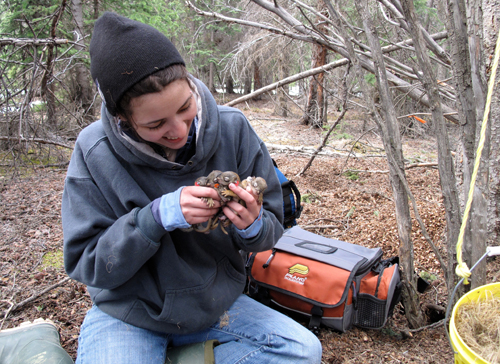
When master’s student Eryn McFarlane spots a squirrel scampering around campus, she can’t help but stop and watch it.
This student’s fascination with the furry creatures happened quite by accident. In a fourth-year evolutionary biology course, McFarlane wrote a proposal to examine whether a female songbird’s propensity to mate with more than one male was heritable.
“When I read her hypothesis, I told her she could test out her hypothesis in my lab, but she would have to use squirrels,” says Prof. Andrew McAdam, who teaches the course.
The integrative biology professor asked McFarlane whether she wanted to lead a research project investigating why female squirrels are so promiscuous. Not only did she spend months at a Yukon squirrel camp collecting data on the animals, but McFarlane also published a paper this winter that captured media attention around the globe.
McAdam is part of the Kluane Red Squirrel Project, a long-term field experiment in Yukon studying the ecology and evolution of red squirrels. Since the project’s establishment in 1987, scientists from collaborating universities, including the University of Guelph, have been monitoring the behaviour and reproduction of about 7,000 squirrels. Researchers, including McFarlane, are continuing to collect data on the population.
Last summer at squirrel camp, McFarlane tagged squirrel pups by attaching pipe-cleaner-type tags to their ears and took a sample of DNA to include each pup in a growing pedigree that now spans seven generations of squirrels. “When we trap the squirrels, we put radio collars on the females who are pregnant so that when they give birth we can follow them to their nest and tag the pups,” says McFarlane. “Trapping the squirrels is definitely challenging. They’re pretty fast.”
McFarlane also spent a semester learning how to analyze the squirrel data for her research project. “I learned to use an animal model that is a specific type of statistical analysis that looks at the relatedness of individuals in a population and determines how heritable a trait is in order to determine how much a trait is influenced by genetics and how much it is influenced by environment,” she says.
In her fourth year, she wrote the research paper and submitted it for publication in Biology Letters, a journal published by the Royal Society of London. Once the paper was publicly released, McFarlane ended up doing interviews for the Globe and Mail, Toronto Star and CBC, as well as a number of international publications.
“What started as an idea from a student in an undergraduate class has led to the publication of a high-profile research study,” says McAdams. “We often use research examples as case studies in classes, but this is one case where teaching has led to new research ideas.”
Before taking McAdam’s evolutionary biology course, McFarlane hadn’t been sure what her plans were. Any ideas she did have definitely hadn’t included squirrels. Now she is completing the first year of her master’s and continuing to study squirrels. She is currently testing two evolutionary hypotheses about the genetics of Darwinian fitness and will spend this spring back at squirrel camp.
“Being a part of the squirrel project has caused me to really pay attention to the nature that surrounds us,” she says. “I find myself listening to birds chirping and watching squirrels scurrying around the ground and running up trees. I had never noticed these things before, and now I find it hard not to notice them.”